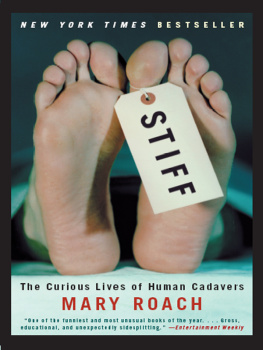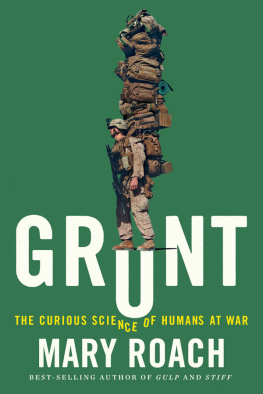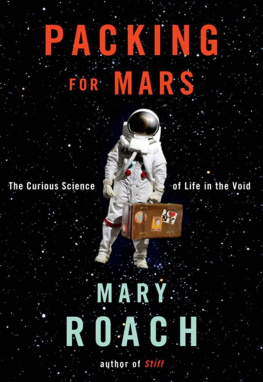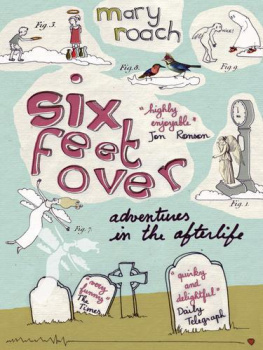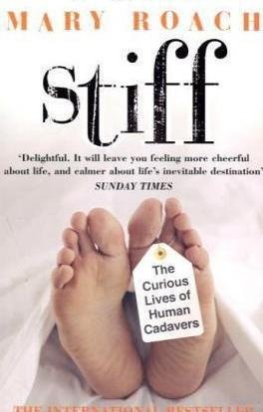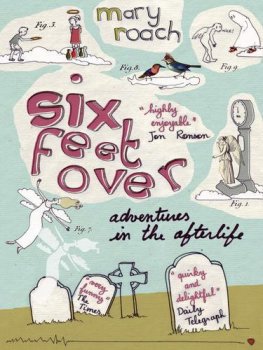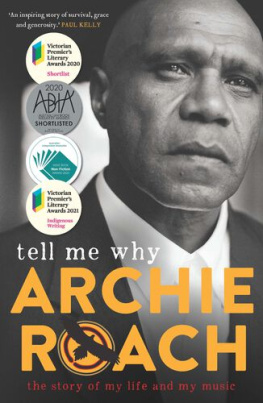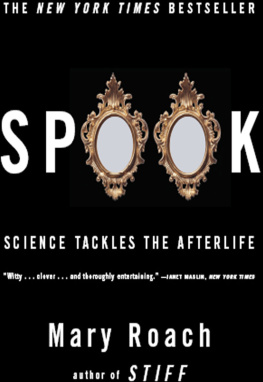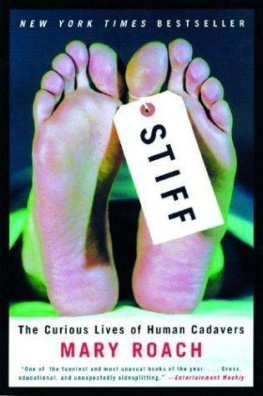Roach - Stiff
Here you can read online Roach - Stiff full text of the book (entire story) in english for free. Download pdf and epub, get meaning, cover and reviews about this ebook. year: 2003, publisher: W.W. Norton & Company, genre: Detective and thriller. Description of the work, (preface) as well as reviews are available. Best literature library LitArk.com created for fans of good reading and offers a wide selection of genres:
Romance novel
Science fiction
Adventure
Detective
Science
History
Home and family
Prose
Art
Politics
Computer
Non-fiction
Religion
Business
Children
Humor
Choose a favorite category and find really read worthwhile books. Enjoy immersion in the world of imagination, feel the emotions of the characters or learn something new for yourself, make an fascinating discovery.
- Book:Stiff
- Author:
- Publisher:W.W. Norton & Company
- Genre:
- Year:2003
- Rating:4 / 5
- Favourites:Add to favourites
- Your mark:
- 80
- 1
- 2
- 3
- 4
- 5
Stiff: summary, description and annotation
We offer to read an annotation, description, summary or preface (depends on what the author of the book "Stiff" wrote himself). If you haven't found the necessary information about the book — write in the comments, we will try to find it.
Roach: author's other books
Who wrote Stiff? Find out the surname, the name of the author of the book and a list of all author's works by series.
Stiff — read online for free the complete book (whole text) full work
Below is the text of the book, divided by pages. System saving the place of the last page read, allows you to conveniently read the book "Stiff" online for free, without having to search again every time where you left off. Put a bookmark, and you can go to the page where you finished reading at any time.
Font size:
Interval:
Bookmark:
* Or almost always. Every now and then, it will happen that an anatomy student recognizes a lab cadaver. Ive had it happen twice in a quarter of a century, says Hugh Patterson, an anatomy professor at the University of California, San Francisco, Medical School.
* But by no means the first to attempt to keep bodies from rotting. Outtakes of the early days of corporeal preservation included a seventeenth-century Italian physician named Girolamo Segato, who devised a way of turning bodies into stone, and a London M.D. named Thomas Marshall, who, in 1839, published a paper describing an embalming technique that entailed generously puncturing the surface of the body with scissors and then brushing the body with vinegar, much the way the Adolphs company would have housewives prick steaks to get the meat tenderizer way down in.
* Does everything have a father? Apparently so. A web search on the father of turned up fathers for vasectomy reversal, hillbilly jazz, lichenology, snowmobiling, modern librarianship, Japanese whiskey, hypnosis, Pakistan, natural hair care products, the lobotomy, womens boxing, Modern Option Pricing Theory, the swamp buggy, Pennsylvania ornithology, Wisconsin bluegrass, tornado research, Fen-Phen, modern dairying, Canadas permissive society, black power, and the yellow schoolbus.
* Other lively things to do with X-ray video cameras: At Cornell University, biomechanics researcher Diane Kelley has filmed lab rats mating in X-ray, in order to shed light on the possible role of the penis bone. Humans do not have penis bones, nor have they, to the authors knowledge, been captured having sex on X-ray videotape. They have, however, been filmed having sex inside an MRI tube, by fun-loving physiologists at the University Hospital in Groningen, Netherlands. The researchers concluded that during intercourse in the missionary position, the penis has the shape of a boomerang.
* From a safety standpoint, it would have been better to skip steering wheels entirely and install a pair of rudderlike handles on either side of the drivers seat, as was done in the Survival Car, a traveling demo car built by the Liberty Mutual Insurance Company in the early 1960s to show the world how to build cars that save lives (and reduce insurance company payouts). Other visionary design elements included a rear-facing front passenger seat, a feature about as likely to sell cars as, well, steering rudders. Safety did not sell automobiles in the sixties, style did, and the Survival Car failed to change the world.
* This is why you shouldnt worry all that much about sitting in the middle seat, without a shoulder belt. If the car gets hit from the side, youre better off being farther from the doors. The kindly people beside you, the ones with the shoulder belts, will absorb the impact for you.
* To quote a Stapp Car Crash Conference study on the topic. Pedestrians are not run over by cars. They are run under. It typically goes like this: Bumper hits calf and front of hood hits hip, knocking the legs out from under and flipping them up over the head. The cartwheeling pedestrian then lands on his head or chest on the hood or windshield. Depending on the speed of the impact, he may continue cartwheeling, legs over head again, and land flat on the roof, and from there slide off onto the pavement. Or he may remain on the hood, with his head smashed through the windshield. Whereupon the driver calls an ambulance, unless the driver is someone like Fort Worth nurses aide Chante Mallard, in which case she keeps on driving, returns to her house, and allegedly leaves the car in the garage with the victim sticking out of her windshield until he bleeds to death. This event took place in October 2001. Mallard was arrested and charged with murder.
* As fans of the eating sections of old Guinness books of world records will surmise, this figure has been surpassed on numerous occasions. Some stomachs, by way of heredity or prolonged daily gourmandism, are roomier than average. Orson Welless was one such stomach. According to the owners of Pinks hot dog stand in L.A., the voluminous director once sat down and finished off eighteen franks.
The all-time record holder would appear to be a twenty-three-year-old London fashion model whose case was described in the April 1985 Lancet . At what turned out to be her last meal, the young woman managed to put away nineteen pounds of food: one pound of liver, two pounds of kidney, a half pound of steak, one pound of cheese, two eggs, two thick slices of bread, one cauliflower, ten peaches, four pears, two apples, four bananas, two pounds each of plums, carrots, and grapes, and two glasses of milk. Whereupon her stomach blew and she died. (The human gastrointestinal tract is home to trillions of bacteria, which, should they escape the confines of their stinky, labyrinthine home, create a massive and often fatal systemic infection.)
Runner-up goes to a thirty-one-year-old Florida psychologist who was found collapsed in her kitchen. The Dade County medical examiners report itemized the fatal last meal: 8700 cc of poorly masticated, undigested hot dogs, broccoli and cereal suspended in a green liquid that contained numerous small bubbles. The green liquid remains a mystery, as does the apparent widespread appeal of hot dogs among modern-day gorgers (from Salon.com).
* This was a subject of heated debate in ophthalmology corners. Some felt that if you made baseballs softer, they would deform on impact and penetrate more deeply into the socket, causing more damage, not less. A study done by researchers at the Vision Performance and Safety Service at Tufts University School of Medicine showed that softer balls did indeed penetrate more deeply, but they didnt cause more damage. That would have been tough to do, for the harder balls ruptured the eye from the limbus to the optic nerve with almost total extrusion of the intraocular contents. Let us hope that the manufacturers of amateur sports equipment have read the March 1999 Archives of Ophthalmology and adjusted the hardness of their baseballs accordingly. Either way, eye protection for Little Leaguers is a swell idea.
* This was a joint effort involving the living and the dead, with the dead getting the shorter end of the stick: Following dissections of the dead penises. 10 healthy males agreed to help confirm the findings by undergoing electrical stimulation of the dorsal nerve, as healthy males are wont to agree to.
* You are perhaps wondering, as I did, whether cadavers were ever used to document the effects of accidental free falls on humans. The closest I came to a paper like this was J. C. Earleys Body Terminal Velocity, dated 1964, and J. S. Cotners Analysis of Air Resistance Effects on the Velocity of Falling Human Bodies, from 1962, both, alas, unpublished. I do know that when J. C. Earley used dummies in a study, he used Dummies in the title, and so I suspect that a few donated corpses did indeed make the plunge for science.
* Im a believer in organ and tissue (bone, cartilage, skin) donation, but was startled to learn that donated skin that isnt used for, say, grafting onto burn victims may be processed and used cosmetically to plump up wrinkles and aggrandize penises. While I have no preconceived notions of the hereafter, I stand firm in my conviction that it should not take the form of someone elses underpants.
* Here is the secret to surviving one of these crashes: Be male. In a 1970 Civil Aeromedical Institute study of three crashes involving emergency evacuations, the most prominent factor influencing survival was gender (followed closely by proximity to exit). Adult males were by far the most likely to get out alive. Why? Presumably because they pushed everyone else out of the way.
* This is no doubt why planes today are not equipped with air bags. Believe it or not, someone actually designed an airplane air-bag system, called the Airstop Restraint System, which combined underfoot, underseat, and chest air bags. The FAA even tested the system on dummies on a DC-7 that it crashed into a hill outside of Phoenix, Arizona, in 1964. While a control dummy in a lap belt fastened low and tight about it jackknifed violently and lost its head, the Airstop-protected dummy fared just fine. The designers were inspired by stories of World War II fighter pilots who would inflate their life vests just before a crash.
Next pageFont size:
Interval:
Bookmark:
Similar books «Stiff»
Look at similar books to Stiff. We have selected literature similar in name and meaning in the hope of providing readers with more options to find new, interesting, not yet read works.
Discussion, reviews of the book Stiff and just readers' own opinions. Leave your comments, write what you think about the work, its meaning or the main characters. Specify what exactly you liked and what you didn't like, and why you think so.

